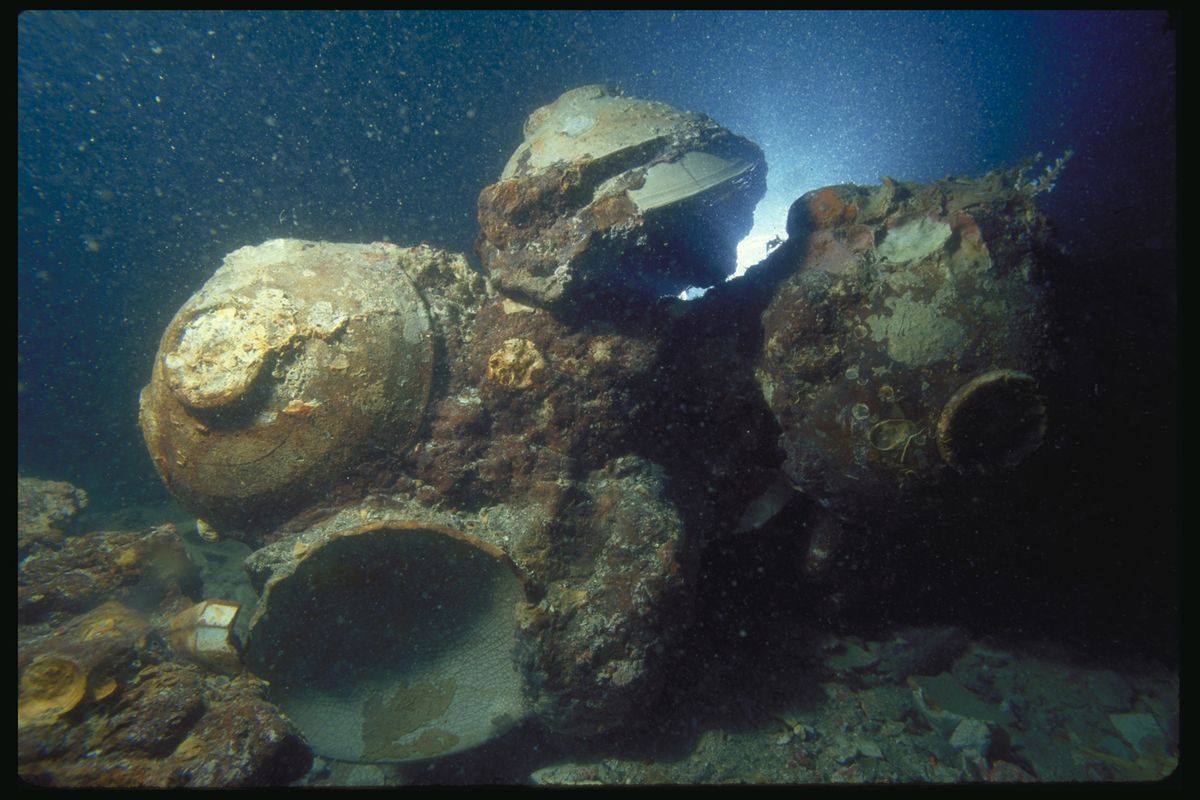12th-Century Shipwreck Came with Handy 'Made in China' Tag

A "Made in China" label stamped onto two ceramic boxes hauled from a shipwreck on the bottom of the Java Sea reveals that the ship went down a century earlier than previously believed.
The Java Sea wreck was once thought to date to the mid- to late 1200s. Now, new radiocarbon dating combined with the bureaucratic jargon on the label puts the real timing of the wreck during the second half of the 1100s, according to new research published today (May 16) in The Journal of Archaeological Science: Reports.
This was a time when the ruling dynasty of southern China was expanding sea trade routes, said study co-author Lisa Niziolek, the Boone research scientist in Asian anthropology at The Field Museum in Chicago. The dynasty's focus on sea trade, Niziolek said, could explain the bevy of treasures aboard the sunken ship: ceramics, some 200 tons (180 metric tons) of cast-iron objects, aromatic resin and even elephant tusks. [See Photos of the Java Sea Shipwreck]
Full collection
The Javan wreck is special because researchers have access to most of its onboard artifacts. In the past, Niziolek told Live Science, salvage operations have often plucked the most desirable items from shipwrecks and left the rest, or sold off collections from wrecks piecemeal.
Pacific Sea Resources, the private company that salvaged the Java wreck in 1996, did something different, however. The organization conducted an archaeologically focused recovery of artifacts, mapping their locations around the wreck and even conducting some radiocarbon dating. The company then donated half the haul to the Indonesian government, as contractually required under typical salvage agreements in the region, and the other half to The Field Museum.
"The fact that Pacific Sea Resources kept their half together is pretty significant," Niziolek said.
Without the variety of artifacts preserved in the museum's collection, Niziolek and her colleagues never would have been able to narrow down the dates in which the ship could have sailed. The researchers used two main lines of evidence to do this. One was state-of-the-art radiocarbon dating of two samples of resin and one sample of elephant tusk. (Pacific Sea Resources had previously dated only one sample of resin, using less-precise methods.)
Sign up for the Live Science daily newsletter now
Get the world’s most fascinating discoveries delivered straight to your inbox.
Radiocarbon dating tests for levels of the radioactive carbon isotope carbon-14. This variation of carbon, which has eight neutrons in its nucleus instead of the more typical six, decays at a known rate, so it acts like an atomic clock inside organic materials.
The dates for the tusk and resins ranged from as early as A.D. 889 to 1261, though most fell into the 11th and 12th centuries — notably earlier than the 13th-century date previously ascribed to the wreck.
Telltale stamp
The second line of evidence was stamped onto the bottom of the wreck's load of ceramics, specifically two ceramic boxes with the same inscription. The inscription, in Chinese characters, read, "Jianning Fu Datongfeng Wang Chengwu zhai yin," which described where the ceramic boxes were made, the prefecture of Jianning Fu in Fujian Province. [Mayday! 17 Mysterious Shipwrecks You Can See on Google Earth]
That "Fu" turned out to be crucial for scientists dating the wreck. It was an administrative word indicating a certain bureaucratic level of prefecture, and Jianning Fu got its name in 1162, during the Southern Song dynasty. In 1278, the Yuan dynasty took over and renamed the prefecture Jianning Lu, indicating another bureaucratic level. Thus, the ceramic boxes must have been manufactured between 1162 and 1278, the researchers concluded.
"It provides the earliest date that the ship could have sailed, which is 1162," Niziolek said.
Web of trade
The new, earlier radiocarbon dates, combined with the inscription, confirmed suspicions by some experts on Chinese ceramics that the wreck might have occurred earlier than the 1300s, Niziolek said.
"With the initial dates, we were more at the transition from the Southern Song dynasty to the Yuan dynasty," she said. Now, it seems more likely that the shipwreck occurred at the beginning of the Southern Song dynasty.
That dynasty was established when the Jin dynasty forced the Song court to move from the north to southern China. The Jin dynasty took over northern China and cut off Song access to many land-based trade routes, Niziolek said. So the Southern Song beefed up its naval prowess and encouraged traders to take to the seas. Prior to this era, she said, China had relied on a tributary trade system, in which foreign traders brought goods to the region.
The next step for Niziolek's team is to unravel all the phases of this trade. The researchers have tested the resins found in the shipwreck and traced them to either Gujarat, India, or some place in Japan. The scientists now hope to use DNA testing to figure out where the elephant tusks originated, Niziolek said. It may even be possible to test the chemical elements in the ceramics and figure out where the pieces were originally produced, she said.
The researchers hope to trace not just the origin of the trade items, but also their final landing points. They're compiling a database of archaeological sites in Southeast Asia, Niziolek said, looking for homes, temples and government buildings where similar artifacts ended up.
Original article on Live Science.

Stephanie Pappas is a contributing writer for Live Science, covering topics ranging from geoscience to archaeology to the human brain and behavior. She was previously a senior writer for Live Science but is now a freelancer based in Denver, Colorado, and regularly contributes to Scientific American and The Monitor, the monthly magazine of the American Psychological Association. Stephanie received a bachelor's degree in psychology from the University of South Carolina and a graduate certificate in science communication from the University of California, Santa Cruz.
Most Popular

